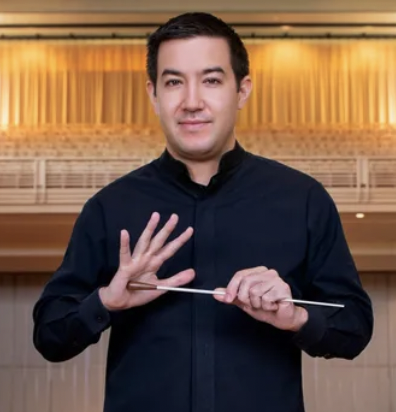|
Symphony
SRS SEASON ENDS WITH RESOUNDING TA-TA-TA-BANG
by Terry McNeill
Sunday, June 1, 2025
Symphony
YOUTHFUL VIRTUOSITY ON DISPLAY AT USO'S MAY CONCERTS
by Peter Lert
Saturday, May 17, 2025
Symphony
MYSTICAL PLANETS AND LIVELY GERSHWIN ORTIZ AT FINAL SRS CONCERT
by Peter Lert
Sunday, May 4, 2025
Symphony
VSO'S CONCERT MUSIC OF TIME, MUSIC OF PLACE
by Peter Lert
Sunday, April 27, 2025
Choral and Vocal
VOCAL ELEGANCE AND FIRE AT THE 222'S RECITAL APRIL 26
by Pamela Hicks Gailey
Saturday, April 26, 2025
CANTIAMO SONOMA SINGS AN INSPIRED GOOD FRIDAY MOZART REQUIEM CONCERT
by Pamela Hicks Gailey
Friday, April 18, 2025
DRAMATIC SHOSTAKOVICH SYMPHONY CLOSES PHILHARMONIC'S 25TH SEASON
by Terry McNeill
Sunday, April 13, 2025
LARGE COLLEGE OF MARIN AUDIENCE GREETS STOPHER ARTISTRY
by Terry McNeill
Saturday, April 5, 2025
Chamber
FRISSON DELIVERS SHIVERS OF DELIGHT
by Abby Wasserman
Sunday, March 30, 2025
OLD AND MOSTLY NEW IN SRS MARCH CONCERT IN WEILL
by Peter Lert
Saturday, March 22, 2025
|
 |
 Conductor Francesco Lecce-Chong |
SHOSTAKOVICH FIFTH THUNDERS AT WEILL HALL CONCERT
by Terry McNeill
Sunday, December 5, 2021
In a new season marketed as “Classical Reunion,” the Santa Rosa Symphony made a palpable connection with its audience at the early December set of three standing ovation concerts in Weill Hall. The December 5 concert, with 1,000 attending, is reviewed here.
Vaughan Williams’ popular Fantasia on a Theme of Thomas Tallis featured gorgeous string sound throughout, and as always the piece seems to evoke peaceful holidays and a sonic aura of the Middle Ages, the composer’s own “Lark Ascending,” and even chant. Attacks and releases are critical here, and conductor Francesco Lecce-Chong drew from his Orchestra long crescendos and diminuendos, with seven contrabasses richly supporting golden solos by violist Elizabeth Prior and concertmaster Joseph Edelberg. The 16-minute work ended with a haunting long decrescendo.
Closing the first half was Hindemith, his 1949 Concerto for Flute, Oboe, Clarinet, Bassoon and Harp. In three movements, the performance had a bright musicality that allowed each of the soloists to be clearly heard from my balcony seat. The sound mix was intriguing with strutting brass, duos from flutist Kathleen Lane Reynolds and harpist Dan Levitan (big sound, not amplified) and in the Rondo finale references to Mendelssohn’s familiar Wedding March theme. Symphony principals Laura Reynolds (oboe) and Roy Zajac (clarinet) were joined by acting principal bassoonist Karla Ekholm.
This was arguably the first large scale Hindemith composition the Symphony has played in some time, and the composer’s splendid “Mathis de Maler” Symphony might be an attractive program item for subsequent seasons.
The Shostakovich D Minor Symphony (the Fifth, Op. 47) began with the conductor’s remarks to the audience regarding the spiritual nature of the music, reminiscent of conductor Jeffrey Kahane’s long ago quasi-political comments to the audience about Shostakovich, Beethoven and Mahler’s courage against political oppression. Virtuoso horn and wind playing characterized the 17-minute Moderato, the strident march passages and massed strings easily sweeping away memories of the concert’s earlier music. This Symphony unfolded thunderously, with compositional references to the earlier Fourth Symphony, and Mr. Lecce-Chong (conducting from score as he did all afternoon) deftly marshalled the instrumental sections into a formidable unit.
Contrary to the overall power of this work, the conductor was able to bring out inner voices among the cymbal crashes, spotlighting the spacious themes in the violins. The brief seven-minute Scherzo featured horn duets of Meredith Wilson and Alex Camphouse, and snappy unison string Pizzicato. Solo mastery continued in the majestic Largo with prominent clarinet and flute passages, celesta and harp lines in juxtaposition with the beautiful melodies coming from the strings and oboe. A faint whiff from the third act prelude of “Tristan und Isolde” was in my mind here, and the sound of the English horn.
The brass was absent in the Largo but certainly made stentorian appearance in the Allegro finale, where the conductor oddly didn’t take an immediate Attaca and opted for a few extra seconds of silence. This movement is a journey of escalating complex orchestra sound, punctuated by mighty timpani from Andrew Lewis, and clangorous percussion (even a snare drum) from Allen Biggs’ section.
There were moments of repose from the harp, violins, and a charming duo of bass violins and cello. However, these were mere moments in a thrilling tapestry of sound, everything triumphant, and Mr. Lecce-Chong guided the continually slowing tempo at the end with its famous dragging timpani notes to tumultuous effect.
The audience seemed stunned for a few seconds by the performance’s impact, then stood for a roaring ovation.
|

